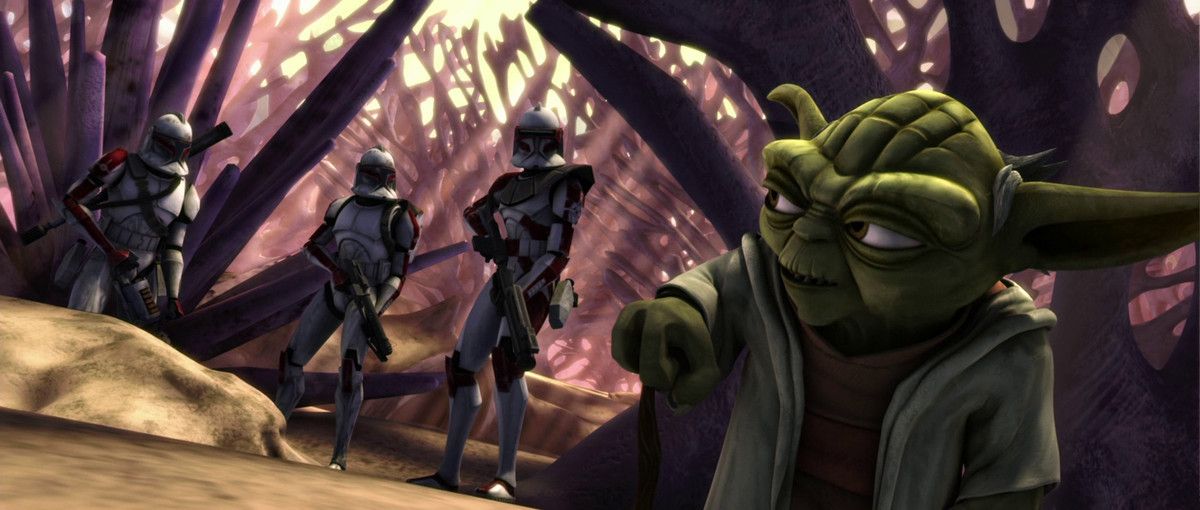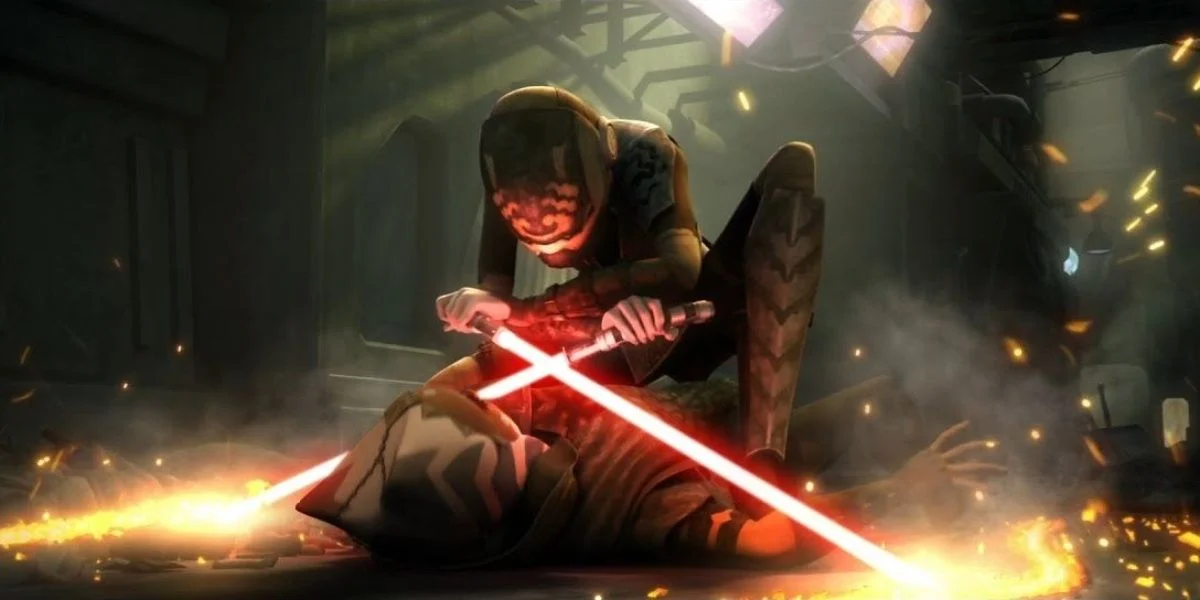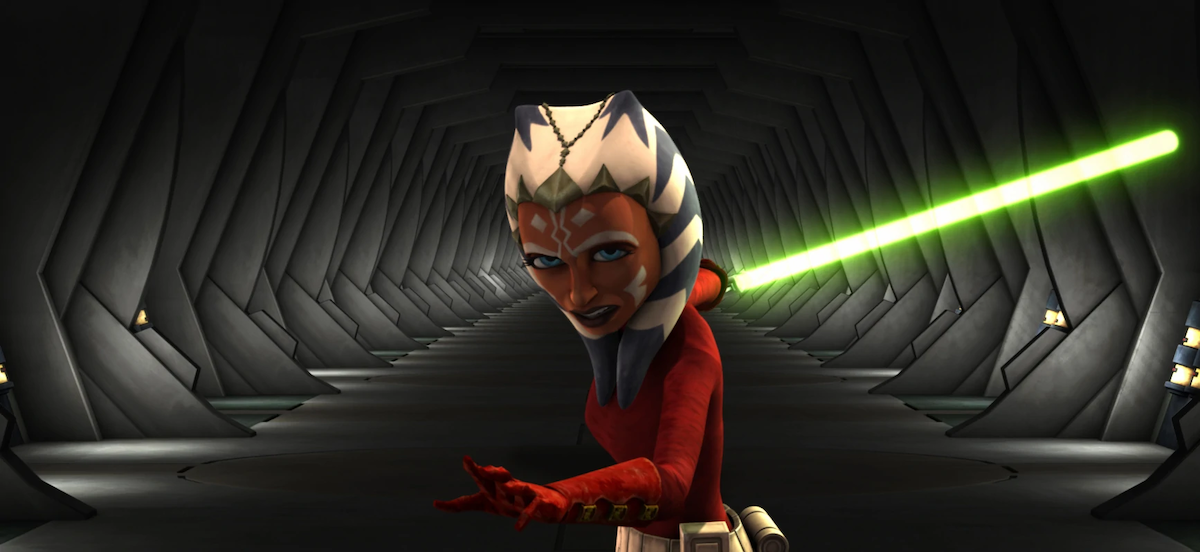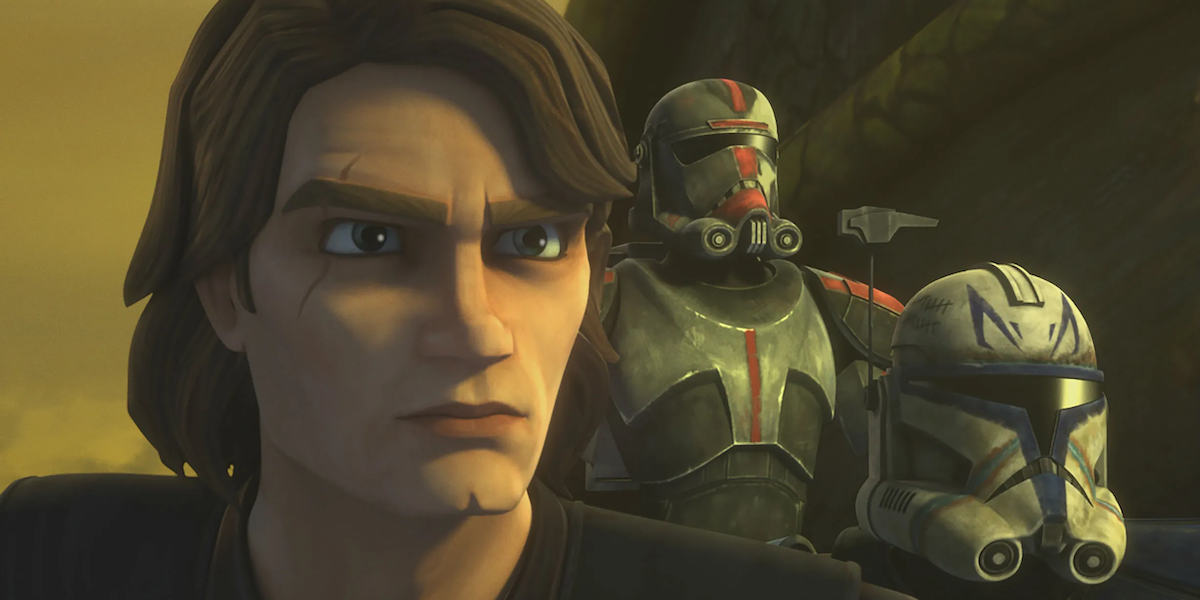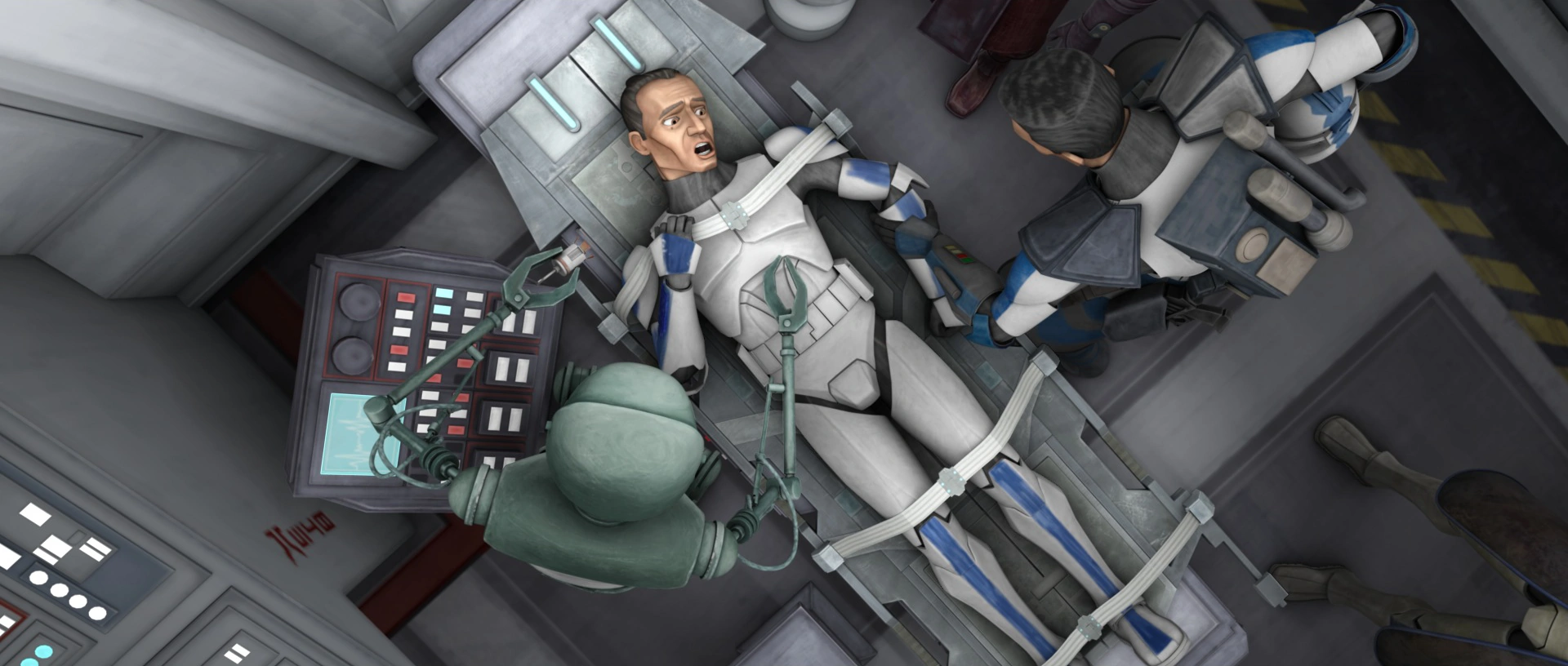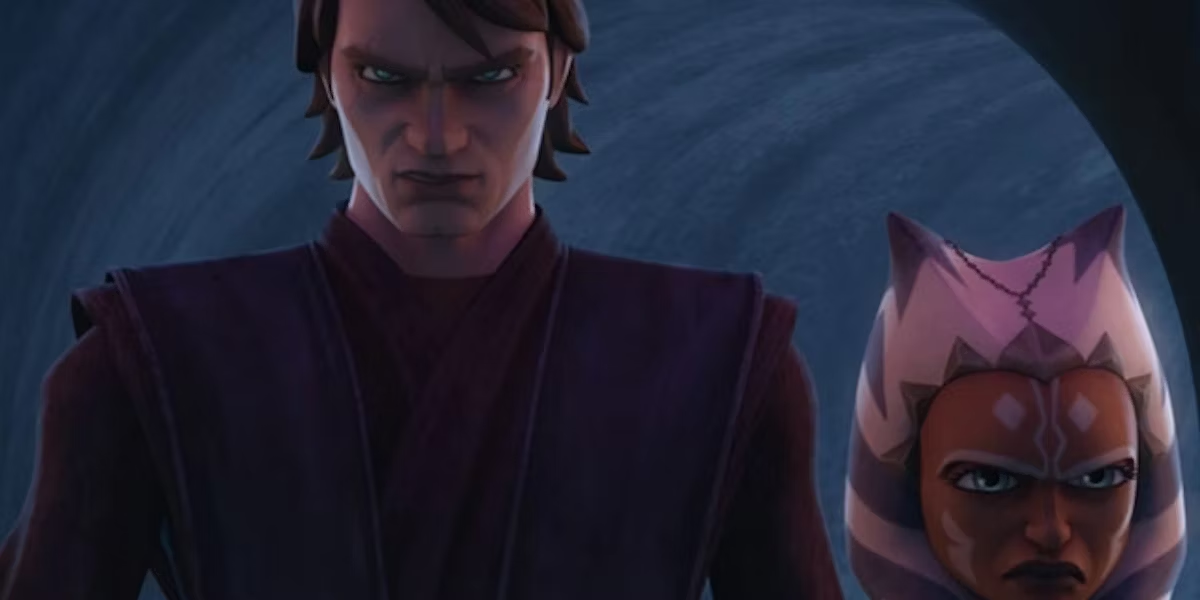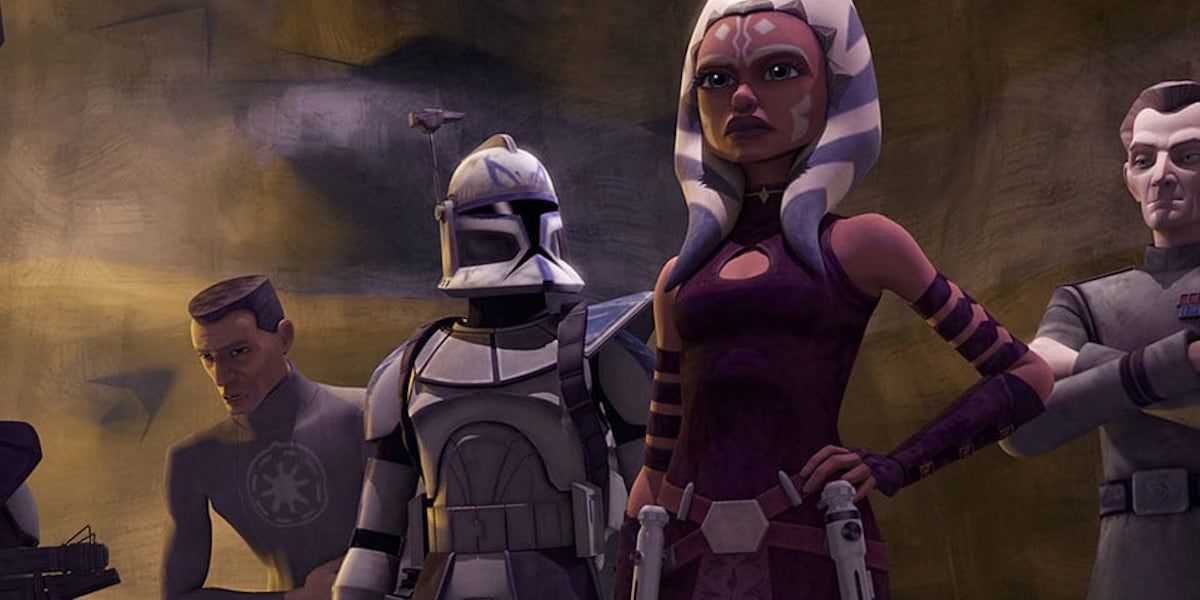After the release of Star Wars: Episode III — Revenge of the Sith in 2005, fans of the galaxy far, far away thought they would never see the franchise return to the screen. George Lucas had indicated that the theatrical saga was over, and Disney didn’t purchase Lucasfilm until 2012. However, fans were entertained during the period by a new set of stories under the leadership of Dave Filoni, a creative force behind Avatar: The Last Airbender. Filoni’s animated series Star Wars: The Clone Wars bridged the gap between the last two prequel films, and showed the “Clone War” that Obi-Wan Kenobi had referenced way back in 1977.
The Clone Wars followed the further adventures of Anakin Skywalker (Matt Lanter) and Obi-Wan Kenobi (James Arnold Taylor) as they adjusted to their new roles as Republic Generals. Anakin begins to show signs of his temptation to join the dark side. Most importantly, the series introduced the new protagonist Ashoka Tano (Ashley Eckstein), who became Anakin’s new apprentice. Ashoka became one of the most beloved characters in the entire Star Wars saga.
The Clone Wars had a rough start. The intended first four episodes of the series were edited into a feature film, which debuted in theaters in August 2008 only months after it was announced. The critically derided film made a lot of fans skeptical, but thankfully the series grew into one of the most beloved entries in the entire saga. Although it was canceled at the end of its fifth season by Cartoon Network, a sixth season debuted on Netflix. The final season premiered on Disney+ last year, and definitively wrapped up Ashoka’s journey. Here is every season of The Clone Wars, ranked worst to best.
7. Season 1
The first season of The Clone Wars showed many signs of promise, but the series had many growing pains. Ashoka’s relationship with Anakin didn’t entirely work in the beginning; in some episodes she was overtly obnoxious and cocky, and occasionally showed signs of her maturation. There were also some truly horrible episodes, such as “Bombad Jedi,” which focused entirely on Jar Jar Binks.
However, the series did begin to show some signs of promise, particularly in its depiction of the clone troopers (all voiced by Dee Bradley Baker). In “Rookies,” Captain Rex and Commander Cody mentor a group of initiate troopers who are stranded on an outpost overrun by droids. Rex and Cody also teamed up in “The Hidden Enemy” to investigate a traitor within the clone army.
There wasn’t a consistent set of villains, as Count Dooku (Corey Burton), Asajj Ventress (Nika Futterman), and General Grievous (Matthew Wood) all were relegated to cameos. However, the season finale did introduce the new bounty hunter Cad Bane (Burton), who would later appear in live-action on The Book of Boba Fett.
6. Season 5
The last series to air on Cartoon Network was not a satisfying conclusion. The series had to be hastily wrapped up following the Disney takeover, and as a result the last aired set of episodes contained entirely of four-part storylines. While this was beneficial during the episodes that centerd on the return of Darth Maul (Sam Witwir), no one wanted to spend four episodes following a group of astromech droids.
A storyline that focuses on a rebel movement on the planet Onderon started out promising, but it did not justify four episodes’ worth of stories. However, these episodes did introduce the character of Saw Gerrera, who Forest Whitaker would portray in Rogue One: A Star Wars Story. While a singular episode focused on youngling Jedi may have been interesting, an entire four part storyline felt like a drag.
The season left many of the show’s biggest unanswered. Maul’s fate is left ambiguous after the death of his brother Savage Opress (Clancy Brown), and Ashoka’s destiny is left open. While she decides to leave the Jedi Order after she’s framed for a conspiracy, Ashoka didn’t get a proper farewell.
5. Season 2
Season 2 showed significant improvements over the first season. While for the most part the show focused on individual episodes, and not multi-episode arcs, the second season did begin to develop some interesting storylines that took the series in a darker direction. In season two, the Mandalorians, a Godzilla-like monster called “The Zillobeat,” and a flame from Padme Amidala’s (Catherine Taber) past all appear.
Season 2 was monikered “Rise of the Bounty Hunters,” and several prominent gunslingers showed up to threaten the heroes. Bane and his accomplice Aurra Sing (Jamie King) returned after their memorable appearances in the season one finale “Hostage Crisis.” The season ended with an epic trilogy of episodes focused on the return of Boba Fett (Daniel Logan), who tries to track down the Jedi that killed his father Jango.
The highlight of the season was a five-part storyline that returned to the planet of Geonosis; this was the planet that the “Clone War” had officially started on in 2002’s Episode II — Attack of the Clones. The intense episodes introduced a new level of combat intensity in the series. There were more experimental genre choices, as a few episodes took a horror-centric direction by introducing zombielike Geonosian warriors.
4. Season 7
The last series of The Clone Wars finally debuted on Disney+ in May 2020, providing a closure to the series that had begun twelve years ago. The last four-part storyline, referred to collectively as “The Siege of Mandalore,” is easily the best of the entire run. The emotional storyline finally confronted Ashoka’s whereabouts during Order 66, and how her relationship with Captain Rex developed. While fans knew her fate already, as she had already appeared again on the follow-up series Rebels, her final stand was still an emotional experience.
However, the strength of the last four episodes shouldn’t mask the fact that the rest of the season is pretty mediocre. The first four episodes introduced a battalion of genetically enhanced clone commandos, who would go on to later lead the spinoff series The Bad Batch. While it’s an entertaining crop of episodes that gives Rex the spotlight, it doesn’t stand out amidst the many great storylines featuring the clones. The next storyline centered on Ashoka, but it chronicled her events before Order 66, when she teams up with a pair of smuggler sisters. These episodes simply feel like filler ahead of the exciting conclusion.
3. Season 6
The Clone Wars’ fate hung in the balance after it was taken off-air, and the sixth season wasn’t really intended to serve as a definitive conclusion. It simply collected a group of storylines that had been completed, but never aired on television. Thankfully, it's a strong collection of stories. Despite a two-part storyline where Jar Jar teams up with Mace Windu (TC Carson), season six had very mature themes. One arc focused on the clone trooper Fives discovering the Order 66 conspiracy, and in another Anakin nearly kills Padme’s former lover Rush Clovis (Robin Atkin Downes) in a brawl lifted straight out of a Nicholas Winding Refn movie.
The highlight of the season was the last arc, in which Yoda travels to the Sith homeworld of Morriban (which fans knew as Korriban from the Expanded Universe). It was nice to see a Yoda-centric story for the first time since the very first episode of the show, “Ambush.” Yoda’s experiences deepened the mythology of the force; he encounters visions of the future, faces off against his darker impulses, and even meets force spirits of fan-favorite Sith Lords like Darth Bane. It was the deepest exploration of the force’s inherent balance before The Last Jedi.
2. Season 4
By the time the fourth season rolled around, The Clone Wars had found its groove in telling extended story arcs. The stories are mostly solid, although a pair of episodes dedicated to R2-D2 and C-3PO (Anthony Daniels) felt closer to the classic Droids cartoon than the darker show that The Clone Wars had become. The season spotlighted Dooku’s betrayal of Ventress, a brutal civil conflict on the planet Mon Calamari, and a gripping storyline where Obi-Wan fakes his own death in order to go undercover with Cad Bane’s bounty hunters.
Four episodes centered on the experiences of Rex and his clones under the command of the new Jedi General Pong Krell, who treats them as subhuman and eventually reveals his allegiance to the Sith. It was a dark period reminiscent of Apocalypse Now. It featured an episode titled “The General” that was directed by Lucas’s early collaborator Walter Murch, one of the most respected sound designers in the industry. The finale fulfilled the promise of Darth Maul’s return, and he finally traded blows with Obi-Wan in a thrilling duel.
1. Season 3
Season 3 was the pinnacle of The Clone Wars. It was the perfect balance of individual spotlight episodes and multi-faced narratives, and easily the most mature of the series. Interesting concepts were explored; season three showed that there were well-intentioned Separatists, shed a spotlight on the clone training process, and developed intrigue based around the Galactic Senate. The season finale “Wookiee Hunt” even featured the return of Chewbacca!
The multipart episode arcs in season three are among the best Star Wars stories in history. Three episodes focused on a breakout mission from a fortress called “The Citadel,” which felt like an homage to ‘70s prison break classics. In one of the most artistic creations of the entire saga, Anakin, Obi-Wan, and Ashoka visit the mysterious force planet Mortis. If you’ve ever wanted to see Star Wars through the lens of Terrence Malick or David Lynch, these were the episodes for you.


